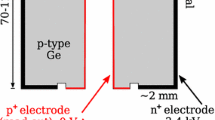Abstract:
New results for the double beta decay of 76 Ge are presented. They are extracted from data obtained with the HEIDELBERG-MOSCOW experiment, which operates five enriched 76 Ge detectors in an extreme low-level environment in the Gran Sasso underground laboratory. The two-neutrino-accompanied double beta decay is evaluated for the first time for all five detectors with a statistical significance of 47.7 kg y resulting in a half-life of T 1/2 2ν = [1.55±0.01(stat)+0.19 -0.15(syst)]×1021 y. The lower limit on the half-life of the 0νββ decay obtained with pulse shape analysis is T 1/2 0ν > 1.9×1025(3.1×1025) y with 90% C.L. (68% C.L.) (with 35.5 kg y). This results in an upper limit of the effective Majorana-neutrino mass of 0.35 eV (0.27 eV) using the matrix elements of A. Staudt et al.'s work (Europhys. Lett. 13, 31 (1990)). This is the most stringent limit at present from double beta decay. No evidence for a majoron-emitting decay mode is observed.
Similar content being viewed by others
Author information
Authors and Affiliations
Additional information
Received: 22 August 2001 / Accepted: 18 October 2001
Rights and permissions
About this article
Cite this article
Klapdor-Kleingrothaus, H., Dietz, A., Baudis, L. et al. Latest results from the HEIDELBERG-MOSCOW double beta decay experiment. Eur Phys J A 12, 147–154 (2001). https://doi.org/10.1007/s100500170022
Issue Date:
DOI: https://doi.org/10.1007/s100500170022



